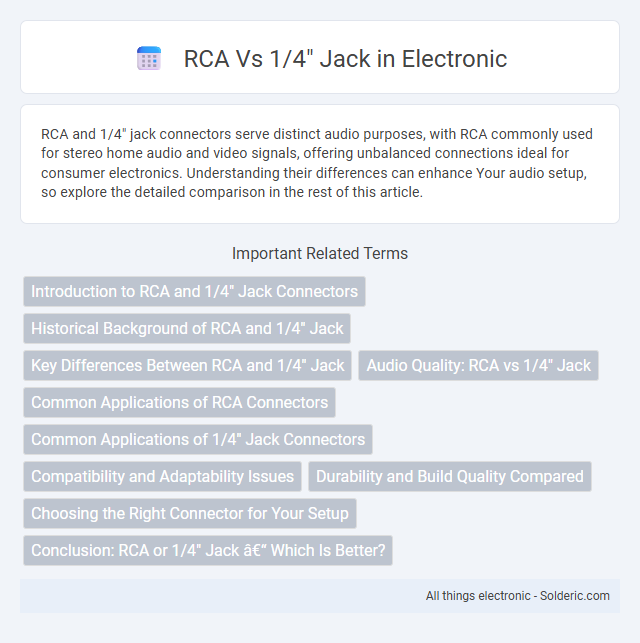RCA and 1/4" jack connectors serve distinct audio purposes, with RCA commonly used for stereo home audio and video signals, offering unbalanced connections ideal for consumer electronics. Understanding their differences can enhance Your audio setup, so explore the detailed comparison in the rest of this article.
Comparison Table
| Feature | RCA Connector | 1/4" Jack |
|---|---|---|
| Type | Analog Audio Connector | Analog Audio Connector |
| Common Uses | Home audio, video devices, stereo systems | Musical instruments, professional audio equipment, headphones |
| Connector Size | Diameter: ~14mm | Diameter: 6.35mm (1/4 inch) |
| Signal Type | Unbalanced stereo or mono audio | Balanced or unbalanced audio (TS or TRS) |
| Features | Color-coded for easy identification (red, white, yellow) | Supports TS (mono) and TRS (stereo/balanced) configurations |
| Durability | Less robust, primarily for home use | More durable, suited for professional use |
| Connection | Push-in, friction fit | Insert and twist for secure fit |
| Typical Cable | RCA cable with signal and ground | Instrument or patch cables with shielded conductor |
Introduction to RCA and 1/4" Jack Connectors
RCA and 1/4" jack connectors serve distinct audio connection purposes, with RCA primarily used for unbalanced, line-level signals in home audio and video equipment, while 1/4" jacks are common in professional audio for balanced or unbalanced instrument and microphone connections. RCA connectors consist of a central pin and an outer ring for signal and ground, respectively, optimized for low-frequency signals. Choosing the right connector depends on your audio equipment compatibility and signal type requirements.
Historical Background of RCA and 1/4" Jack
The RCA connector, introduced in the 1940s by the Radio Corporation of America, was designed primarily for consumer audio and video equipment, revolutionizing home entertainment with its ease of use and reliable signal transmission. The 1/4" jack, dating back to the early 20th century, originated in telephone switchboards and later became a staple in professional audio, especially for musical instruments and studio gear due to its durability and balanced audio capabilities. Understanding the historical evolution of these connectors helps you appreciate their specific roles in modern audio systems and choose the right interface for your equipment.
Key Differences Between RCA and 1/4" Jack
RCA connectors are primarily used for consumer audio and video equipment, delivering unbalanced signals typically in home stereo or TV setups, while 1/4" jacks are common in professional audio environments, offering both balanced and unbalanced options suited for instruments and studio gear. RCA cables usually transmit line-level signals and lack the durability of 1/4" jacks, which are built to endure frequent plugging and unplugging. Understanding these key differences helps you choose the right connector type based on signal quality, durability, and application requirements.
Audio Quality: RCA vs 1/4" Jack
RCA connectors typically provide a balanced audio signal, ensuring clear sound with minimal interference, making them ideal for consumer audio devices. 1/4" jacks, especially balanced TRS versions, offer superior noise rejection and higher fidelity, preferred in professional audio settings for delivering pristine sound quality. Your choice depends on whether you prioritize convenience and compatibility (RCA) or enhanced audio performance and durability (1/4" jack).
Common Applications of RCA Connectors
RCA connectors are commonly used for audio and video applications, including connecting DVD players, televisions, and stereo systems, making them essential in home entertainment setups. Their color-coded design simplifies wiring for composite video and analog audio signals, ensuring clear signal transmission. You will often find RCA connectors in older consumer electronics and professional audio equipment where reliable analog connectivity is required.
Common Applications of 1/4" Jack Connectors
1/4" jack connectors are widely used in professional audio equipment, including electric guitars, amplifiers, and headphones for their durability and secure connection. They commonly appear in studio environments for patch cables, instrument inputs, and balanced audio connections in mixers and audio interfaces. Your setup benefits from the 1/4" jack's versatility and reliable signal transmission in both mono and stereo configurations.
Compatibility and Adaptability Issues
RCA connectors primarily support unbalanced stereo signals commonly used in consumer audio equipment, whereas 1/4" jacks accommodate both balanced and unbalanced connections in professional audio settings. Your ability to connect devices can be limited by cable type and impedance differences, making adapters or specialized cables necessary for seamless integration. Understanding these compatibility constraints ensures optimal audio quality and prevents signal degradation when interfacing between RCA and 1/4" jack systems.
Durability and Build Quality Compared
RCA connectors typically feature a simple metal tip and sleeve design that offers moderate durability but can be prone to wear and looseness over time, especially with frequent plugging and unplugging. In contrast, 1/4" jacks, often constructed with robust metal casings and sturdy internal contacts, provide superior build quality that withstands heavy use and mechanical stress better. If your setup requires reliable, long-lasting connections, investing in 1/4" jacks ensures enhanced durability and consistent performance.
Choosing the Right Connector for Your Setup
Choosing the right connector for your setup depends on the type of equipment and intended use. RCA connectors are commonly used for stereo audio and composite video signals, offering color-coded simplicity ideal for home audio systems and older devices. 1/4" jacks provide robust, professional-grade connections preferred for musical instruments and audio equipment, ensuring durability and high-quality signal transmission.
Conclusion: RCA or 1/4" Jack – Which Is Better?
RCA connectors excel in consumer audio setups due to their widespread compatibility and ease of use, while 1/4" jacks are preferred in professional audio environments for their durability and secure connection. The choice depends on application: RCA suits home stereo systems and non-professional gear, whereas 1/4" jacks are ideal for instruments, studio equipment, and live sound where reliability is crucial. Prioritizing connection type based on device compatibility and usage context ensures optimal audio performance.
RCA vs 1/4" jack Infographic

 solderic.com
solderic.com